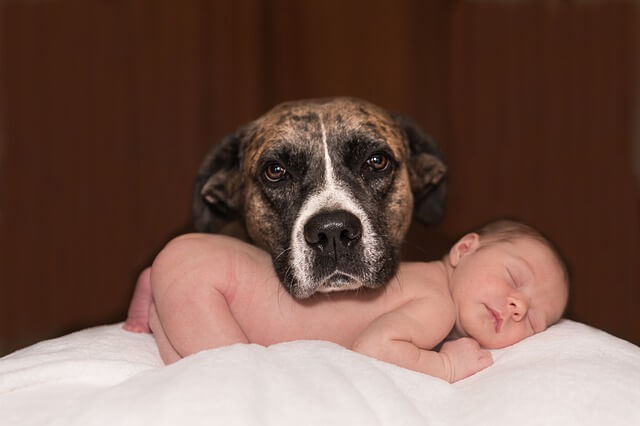How to Prepare Your Pets for the Arrival of a New Baby

It’s normal and natural for new parents to focus all of their attention on their newborn son or daughter. However, this is a problem if there are pets in the home.
Your pets will no longer receive the dose of attention that they’re used to, and this can cause alterations in behavior. In general, one of two things happens. Your pets may either become anxious or depressed.
Pets suffer as the result of change
When changes occur in a pet’s environment, they sense it immediately. In the case of cats and dogs, it’s very common for them to become afraid, of course, as a result of their curiosity.
Now, it’s impossible to know for sure how an animal will react – you can only make assumptions. Just the same, it’s best to prepare your pets for the arrival of a new baby, since this presents a major change.
Our goal should be to get our animals excited about the arrival of a new baby, and not afraid. If your pets feel afraid, they may react in an inappropriate way.

How to prepare your pets for the arrival of a new baby
Long before your baby’s birth, you should prepare your pets for any unexpected situation. Remember that babies are full of surprises and anything can happen when you have a little one in the house.
Therefore, we recommend taking the following actions:
Look for a comfortable place for your pet
This is one of the first things you need to think about, especially if your pet is used to running around without any type of restrictions.
No, this doesn’t mean you should shut your pet away. But you do need to attempt to teach your animals not to stay in certain places for too long. And there may be areas of the home that your pet will need to learn to avoid altogether.
For example, if you have a cat, you should teach your cat to stay away from the baby’s room. Remember that felines tend to jump up on any surface, and this isn’t good for your newborn baby.
It’s especially important to teach your cat not to crawl on or sleep on your baby’s crib.
As for dogs, you must teach them to socialize and be tolerant. Of course, the details will depend on the dog’s breed and the amount of time you spend with him.
There are some dogs that become very protective of children and even sleep at the feet of their cribs or beds to take care of them.
Look for new activities
To get your cats and dogs ready for your little one’s arrival, you need to find activities they can enjoy without your company. This is especially true if your pet is used to spending a lot of time following you around.
Remember that the arrival of a new baby requires hours of your attention. Your pet may easily feel replaced and become depressed.
Get your pet used to new sounds
Remember that animals have a very developed sense of hearing –much more than that of human beings. It’s very likely your pet will have to put up with long hours of your child’s crying, and this can be unnerving.
To keep your pet from becoming overly frightened, you can use recordings of babies crying. Another useful trick is to keep the radio turned on at low volume. This will get your dog or cat used to hearing a certain amount of noise in its environment.
Get your pet used to your baby’s room
You may very well spend many hours in your baby’s room. Therefore, prepare your furry family members well in advance for this reality.
Get them used to seeing you spend time there. Furthermore, allow your pet to become familiar with different baby items. Allow your animals to smell the baby’s shampoo and lotion, to hear the sound of your baby’s toys, and to get to know your baby’s clothing.
This way, your dog will understand that your baby is a part of your home.

After the arrival of a newborn baby
Now you know some of the tricks of getting your pets ready for the coming of a new addition to your family. But it’s also important to talk about what to do once your baby is already in your home.
To begin, avoid leaving your pet out. Greet your pet and give him love and affection. Take time to remind your pet of how much you love him and how good he is.
Introduce your baby to your pets progressively to keep them from becoming afraid. Little by little, your cats and dogs will get used to the scent and presence of your new son or daughter.
The first months with your new baby.
At first, it’s best to put up a gate in your baby’s doorway to keep your pet from entering. When you feel more comfortable, you can allow your pet to enter the room with your permission and company, for limited amounts of time.
When your baby is small, you should never leave him or her alone with your pets. Your cats and dogs aren’t necessarily looking to hurt your little one, but you don’t want any sudden movements to put your child in harm’s way.
If your pet isn’t used to rough play, you’ll need to get him ready for when your child starts to crawl. Remember that your baby doesn’t know how to foresee danger. He or she will likely be tempted to pull, pinch or push your cats and dogs out of simple curiosity.
When your child starts crawling, he or she will likely already have developed a strong bond with your pet. However, you should always be present and supervise their interactions at all times.
This text is provided for informational purposes only and does not replace consultation with a professional. If in doubt, consult your specialist.








